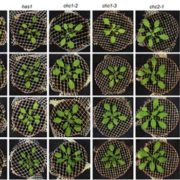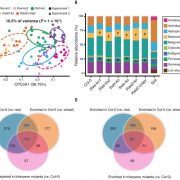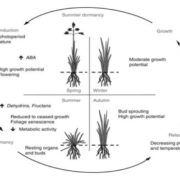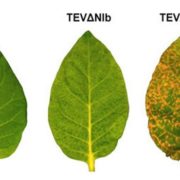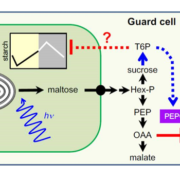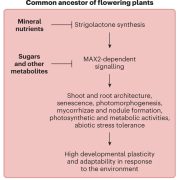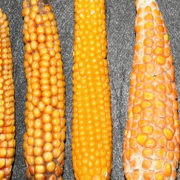Review: Senescence and nitrogen use efficiency in perennial grasses for forage and biofuel production ($)
 Much of our understanding of the molecular processes of senescence and nutrient remobilization comes from annual plants. Yang and Udvardi explore how these processes take place in perennial grasses including important biofuel grasses switchgrass (Panicum virgatum) and miscanthus (Miscanthus×giganteus). While in annual plants leaf senescence is usually accompanied by mobilization of nutrients from leaves to seeds, in perennials some of the nutrients mobilized from the leaves is stored in underground organs (roots, rhizomes and crowns) and so not removed from the site, thus requiring less input of fertilizers during the next season. Note that biofuel plants are grown for their carbon-rich biomass, so enhancing N-remobilization into below-ground storage would be environmentally advantageous; by contrast, perennial grasses grown as animal fodder must retain some N-rich proteins in their harvested matter. The authors explore what is known about remobilization in perennial grasses and strategies to breed or engineer improvements, including through changing the timing of reproduction or leaf senescence. J. Exp. Bot. 10.1093/jxb/erx241
Much of our understanding of the molecular processes of senescence and nutrient remobilization comes from annual plants. Yang and Udvardi explore how these processes take place in perennial grasses including important biofuel grasses switchgrass (Panicum virgatum) and miscanthus (Miscanthus×giganteus). While in annual plants leaf senescence is usually accompanied by mobilization of nutrients from leaves to seeds, in perennials some of the nutrients mobilized from the leaves is stored in underground organs (roots, rhizomes and crowns) and so not removed from the site, thus requiring less input of fertilizers during the next season. Note that biofuel plants are grown for their carbon-rich biomass, so enhancing N-remobilization into below-ground storage would be environmentally advantageous; by contrast, perennial grasses grown as animal fodder must retain some N-rich proteins in their harvested matter. The authors explore what is known about remobilization in perennial grasses and strategies to breed or engineer improvements, including through changing the timing of reproduction or leaf senescence. J. Exp. Bot. 10.1093/jxb/erx241


